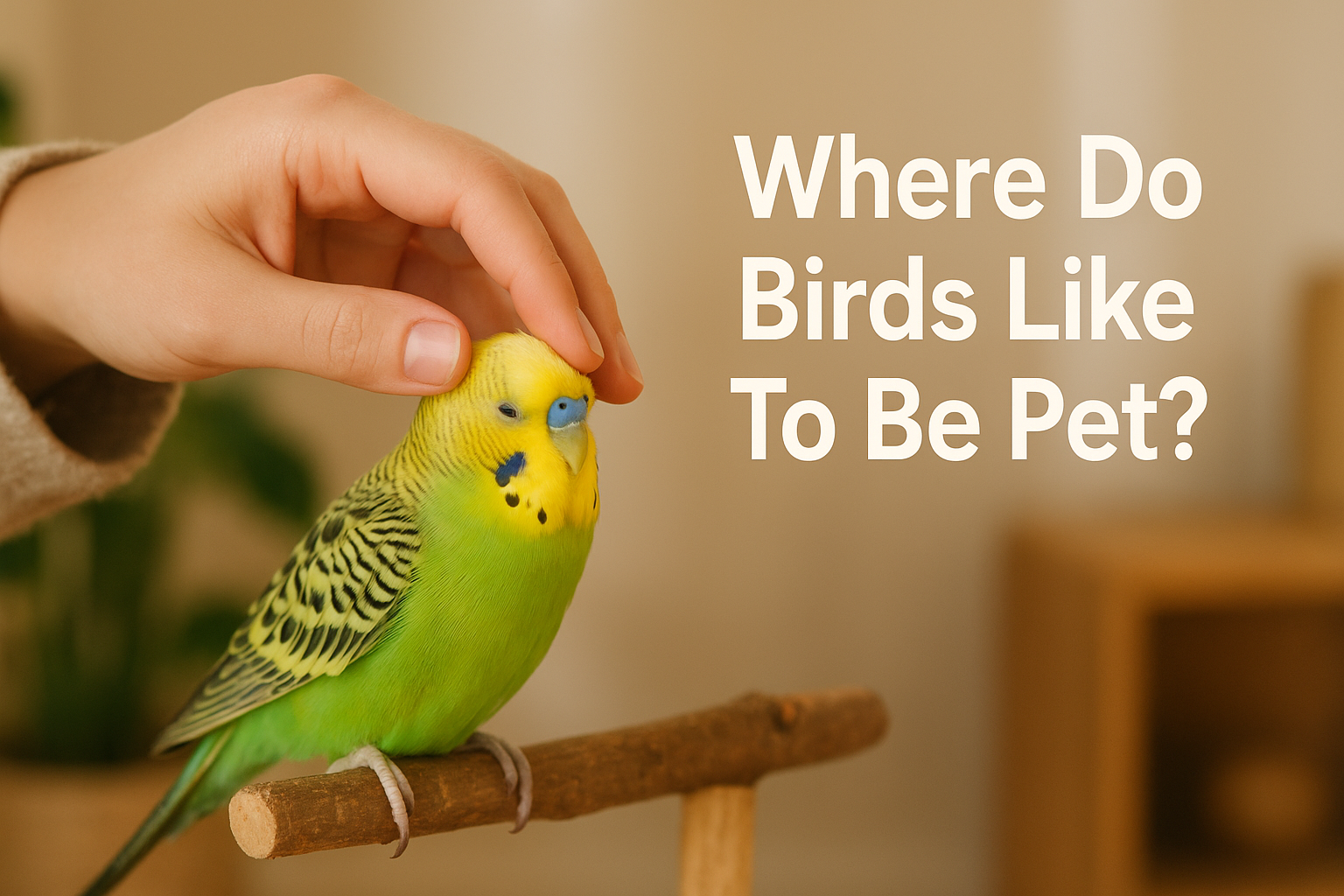You need to know how your bird feels and acts before you can figure out where it likes to be petted. Birds are smart and careful animals that depend on trust a lot. They don’t immediately accept touch like cats or dogs do; they need time to get used to being around people.
When a bird feels safe, it will show signs like relaxed feathers, soft chirping, or a head that is slightly tilted. These gestures show that the person is interested and calm, which is a great time to start gentle touch. Being patient is important because rushing into petting too soon can make someone scared or distrustful.
Why Trust Is Important Before Petting?
Trust is what makes a bird and its owner get along. Spend time near your bird every day, talk to it softly, and let it get used to you being there. Instead of making your bird interact with you, let it come to you first.
Your bird will start to show you love by getting closer or making sounds that sound like you when you trust it. At this point, it’s easier to find out where birds like to be petted without making them feel stressed or uncomfortable.
The best places to pet your head and neck
Birds like to be petted on their heads and necks the most, and these are also the safest places to do so. It’s hard for birds to get to these places when they’re grooming, so they like it when you help them preen. With your fingertips, lightly stroke the feathers on the head, behind the eyes, or around the neck.
This touching is like the way birds groom each other in the wild, which builds trust and love. When parrots, cockatiels, and conures want gentle scratches in these areas, they often lower their heads. This is a clear sign that they feel relaxed and loved.
Around the Face and Under the Beak
Some birds also like it when you lightly touch them under their beak or on the sides of their face. Be careful and go slowly in these areas because they are sensitive. Watch how your bird reacts closely.
If your bird leans in, puffs up its feathers a little, or closes its eyes, that’s a good sign. But if it flinches, steps back, or raises its feathers, you should stop. These small body language signs will help you figure out where birds like to be petted without making them nervous.
Places You Shouldn’t Pet
Some places are fine to touch lightly, but others should be avoided at all costs. You should never pet a bird on its back, wings, belly, or tail. These areas are very sensitive and can cause people to act in ways they don’t want to.
Touching these areas releases hormones in many species that can cause aggression or mating behaviour. Keeping your pet’s head, neck, and upper chest calm, friendly, and happy is the best way to do it. Knowing where birds like to be petted will make both you and your bird feel better.
How to Pet Your Bird?
Always move slowly and stay at eye level when you get close to your bird. Birds may feel threatened if you move suddenly or touch them from above because predators usually attack from higher angles.
Talk to your bird in a soft voice and show it your hand before you touch it. Don’t press too hard and move your fingers in the direction of the feathers, not against them. Your bird will learn to associate your touch with comfort and safety when you stroke it gently.
This method works best when you talk to your bird in a calm voice or whistle quietly. This will make your bird feel safe and secure. As time goes on, your pet will look forward to these times of love, which will make your bond stronger.
Different Birds Like Different Things
Not all birds like being touched in the same way. Larger parrots, like macaws, African greys, and cockatoos, often want to be touched and enjoy being petted once they trust their owners. Medium-sized birds like cockatiels, quakers, and conures usually like to be petted only a little.
But smaller birds, like finches or canaries, usually don’t like to be handled much. For these fragile species, talking to them and spending time with them is a better way to show them you care than touching them. You can figure out where birds like to be petted and how to make them feel comfortable by knowing these differences between species.
Signs That Your Bird Likes Being Petted
It’s important to know how your bird acts when you pet it. A happy bird might lower its head, fluff up a little, or close its eyes to show that it is happy. Some will coo, chirp softly, or even lean into your hand to ask for more.
When your bird moves away, raises its crest, or starts to nip, it is telling you that it is in pain. Pay attention to these signs right away. Not paying attention to them could make your bird anxious or make them lose trust in you. Recognising and responding to these signals makes sure that petting stays a calming and positive experience.
Knowing the limits of petting
Birds, like people, have their own personal space. They might like a scratch today, but they might not want to be touched tomorrow. This change in behaviour doesn’t mean your bird doesn’t like you; it just shows how it feels.
Knowing how to pet birds safely means learning to respect their space. To keep a peaceful, loving bond, you need to be patient, watchful, and understanding.
Making the Right Place for Petting
The surroundings have a big effect on how at ease a bird is. When you play with your pet, pick a quiet room with few things to do. Birds can get scared by loud noises, bright lights, or people they don’t know.
Make sure your movements are soft and easy to understand. Your bird will respond better to touch if it feels safe in its surroundings. To help your bird connect petting with love instead of fear, you need to be consistent and keep things calm.
Touching to Make an Emotional Connection
If you do it right, petting your bird can make you feel closer to them. Birds see gentle grooming as a sign that you trust them and are friends with them. They’ll start to come up to you on their own, tilt their heads, or even groom your hair or fingers in return as time goes on. This is a clear sign that you care about them and love them.
This link is what makes it fun to find out where birds like to be touched. You’re not just showing love; you’re also building a way to communicate that doesn’t need words.
FAQs
1. What part of their body do birds like to be touched the most?
Most birds enjoy having their heads, necks, and faces stroked gently. These are safe and comfortable places that look like natural preening.
2. Should I pet the wings or the back of my bird?
No. Do not touch your bird’s back, wings, belly, or tail because these areas can make it stressed or act in ways that are not normal.
3. How can I tell if my bird likes being petted?
It’s a good sign that your bird likes the touch if it relaxes, lowers its head, or closes its eyes. Moving away or biting shows that something hurts.
4. Do all types of birds like to be petted?
Some birds don’t like to be touched. Parrots and cockatiels like to be touched a lot, but smaller birds like finches and canaries don’t.
5. What can I do to help my bird get used to being petted?
Talk to your bird softly and spend time near it every day. Let it come to you. If you build trust first, petting will be much easier and more fun.
6. Will petting my bird make our bond stronger?
Yes. Petting your bird gently and with respect can help build trust and an emotional bond between you and your bird.
The end
Knowing where birds like to be petted can help you get closer to your feathered friend. Birds like it when you pet them gently on the head, neck, and face, which is how they groom themselves in the wild. To avoid stress or hormonal triggers, stay away from sensitive areas like the back, wings, or tail.
Each bird has its own personality. Some people like to be touched every day, while others only want to be touched a few times a week. The most important thing is to watch and respect your bird’s space. Go slowly, move carefully, and always let your bird lead the way.
You can build a trusting, loving relationship with your bird that gets stronger with every touch by knowing and respecting its comfort zones. Petting isn’t just a physical thing; it’s a way to talk to your bird emotionally that will make you friends for life.


